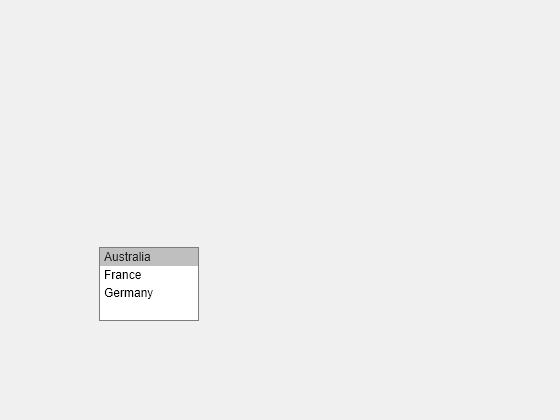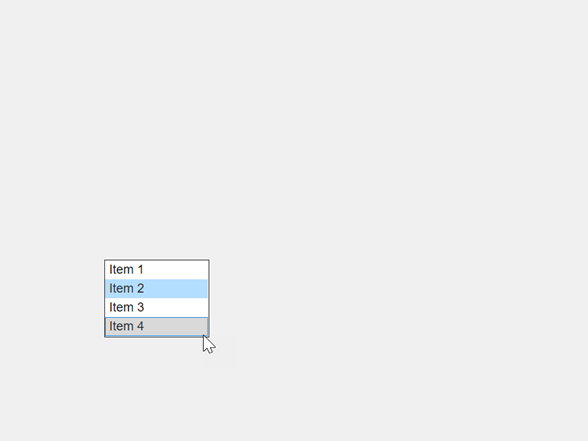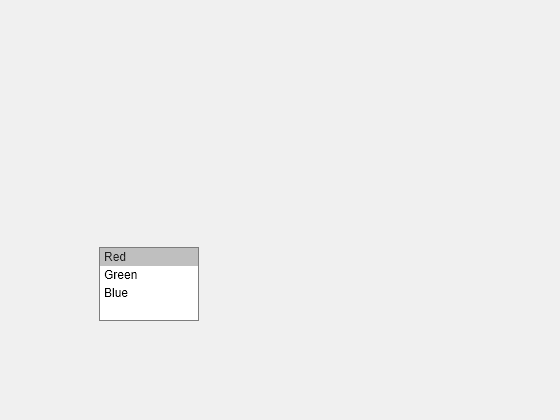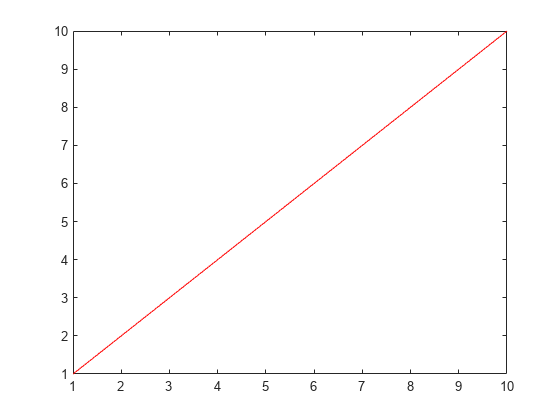uilistbox
创建列表框组件
说明
lb = uilistboxListBox 对象。MATLAB® 调用 uifigure 函数来创建该图窗。
lb = uilistbox(___,Name,Value)uilistbox("Multiselect","on") 创建一个允许 App 用户选择多个项目的列表框。
示例
在 UI 图窗中创建一个列表框,并指定列表框项目。
fig = uifigure; lb = uilistbox(fig,"Items",["Australia","France","Germany"]);

查询所选项目的值。
val = lb.Value
val = 'Australia'
以编程方式更新列表框选择。
lb.Value = "Germany";
在 UI 图窗中创建列表框。允许 App 用户选择多个项目。
fig = uifigure; lb = uilistbox(fig,"Multiselect","on");
通过点击时按住 Ctrl 键,在列表框中选择多个项目。

Value 属性将所有所选项目存储为一个元胞数组。
val = lb.Value
val =
1×2 cell array
{'Item 2'} {'Item 4'}在 UI 图窗中创建一个列表框,并通过设置 Items 属性指定一个列表框中的颜色名称列表。
fig = uifigure; lb = uilistbox(fig,"Items",["Red","Green","Blue"]);

当没有与项目相关联的数据时,列表框的 Value 属性是 Items 中的一个元素。
val = lb.Value
val = 'Red'
通过设置 ItemsData 属性,将十六进制颜色数据与列表框项目相关联。设置 ItemsData 不会更改项目向 App 用户显示的方式。
lb.ItemsData = ["#F00","#0F0","#00F"];

当 ItemsData 属性非空时,列表框的 Value 属性是 ItemsData 中的一个元素。
val = lb.Value
val = "#F00"
指定 ItemsData 有利于更轻松地执行与所选项目相关联的操作。例如,通过将十六进制颜色值直接传递给 plot 函数,用所选颜色绘制一些数据。
plot(1:10,"Color",lb.Value)
创建一个 App。当用户选择列表框项目时,该 App 会更新颜色图。
在名为 colormapApp.m 的文件中,编写实现该 App 的函数:
创建一个 UI 图窗和一个网格布局管理器,以对该 App 进行布局。
在网格布局管理器中用一些绘制的数据创建一个列表框和 UI 坐标区。
编写一个名为
listBoxValueChanged的回调函数来更新 UI 坐标区的颜色图,并将该函数赋给列表框的ValueChangedFcn回调属性。有关回调的详细信息,请参阅Create Callbacks for Apps Created Programmatically。
function colormapApp fig = uifigure; g = uigridlayout(fig,[3 2]); g.RowHeight = {'1x','fit','1x'}; g.ColumnWidth = {'fit','1x'}; lb = uilistbox(g, ... "Items",["Spring","Summer","Autumn","Winter"], ... "ItemsData",{spring,summer,autumn,winter}); lb.Layout.Row = 2; lb.Layout.Column = 1; ax = uiaxes(g); ax.Layout.Row = [1 3]; ax.Layout.Column = 2; surf(ax,peaks) colormap(ax,spring) lb.ValueChangedFcn = @(src,event) listBoxValueChanged(src,event,ax); end function listBoxValueChanged(src,event,ax) cmap = event.Value; colormap(ax,cmap) end
运行 colormapApp 函数。在列表框中选择一个项目以更改颜色图。
colormapApp

自 R2023a 起
创建一个列表框,其中包含三个表示不同图像的项目。
fig = uifigure; lb = uilistbox(fig,"Items",["Peppers","Nebula","Street"]);
用对应于列表框项目的图标创建三个样式。
s1 = uistyle("Icon","peppers.png"); s2 = uistyle("Icon","ngc6543a.jpg"); s3 = uistyle("Icon","street1.jpg");
向列表框项目添加样式以显示图标。
addStyle(lb,s1,"item",1); addStyle(lb,s2,"item",2); addStyle(lb,s3,"item",3);
![]()
输入参数
父容器,指定为 Figure 对象或其子容器之一:Tab、Panel、ButtonGroup 或 GridLayout。如果不指定父容器,MATLAB 会调用 uifigure 函数创建新 Figure 对象充当父容器。
名称-值参数
以 Name1=Value1,...,NameN=ValueN 的形式指定可选参量对组,其中 Name 是参量名称,Value 是对应的值。名称-值参量必须出现在其他参量之后,但参量对组的顺序无关紧要。
示例: uilistbox(Items=["Model 1","Model 2","Model 3"]) 指定列表框项目。
在 R2021a 之前,使用逗号分隔每个名称和值,并用引号将 Name 引起来。
示例: uilistbox("Items",["Model 1","Model 2","Model 3"]) 指定列表框项目。
注意
此处所列的属性只是可用属性中的一部分。有关完整列表,请参阅 ListBox。
列表框项目,指定为字符向量元胞数组、字符串数组或一维分类数组。允许重复的元素。列表框显示的选项与 Items 数组中的元素数量一样多。如果将此属性指定为分类数组,MATLAB 将使用数组中的值,而不是完整的类别集。
与 Items 属性值的每个元素关联的数据,指定为 1×n 数值数组或 1×n 元胞数组。允许重复的元素。
例如,如果您将 Items 值设置为员工姓名,则可以将 ItemsData 值设置为对应的员工 ID 号。ItemsData 值对 App 用户不可见。
如果 ItemsData 值和 Items 值中的数组元素数量不匹配,将发生以下情况之一:
如果
ItemsData值为空,则Items值的所有元素都呈现给 App 用户。如果
ItemsData值中的元素数大于Items值,则Items值的所有元素都呈现给 App 用户。MATLAB 将忽略多余的ItemsData元素。如果
ItemsData值非空,但元素数少于Items值,只将在ItemsData值中具有对应元素的Items值的元素呈现给 App 用户。
示例: {'One','Two','Three'}
示例: [10 20 30 40]
多项目选择,指定为 'off' 或 'on',或者指定为数值或逻辑值 1 (true) 或 0 (false)。值 'on' 等效于 true,'off' 等效于 false。因此,您可以使用此属性的值作为逻辑值。该值存储为 matlab.lang.OnOffSwitchState 类型的 on/off 逻辑值。
如果将此属性设置为 'on',则允许用户同时选择多个项目。
更改值后执行的回调,指定为下列值之一:
函数句柄。
第一个元素是函数句柄的元胞数组。元胞数组中的后续元素是传递到回调函数的参量。
包含有效 MATLAB 表达式的字符向量(不推荐)。MATLAB 在基础工作区计算此表达式。
当用户从列表框中选择不同的项目时,将会执行此回调函数。如果以编程方式更改 Value 属性设置,将不会执行此回调函数。
此回调函数可以访问有关用户与列表框的交互的特定信息。MATLAB 将 ValueChangedData 对象中的此信息作为第二个参量传递给回调函数。在 App 设计工具中,该参量名为 event。您可以使用圆点表示法查询对象属性。例如,event.PreviousValue 返回列表框的上一个值。ValueChangedData 对象不可用于指定为字符向量的回调函数。
下表列出了 ValueChangedData 对象的属性。
| 属性 | 值 |
|---|---|
Value | App 用户最近一次交互之后列表框的值 |
PreviousValue | App 用户最近一次交互之前列表框的值 |
ValueIndex | App 用户最近一次交互之后项目中列表框值的索引 |
PreviousValueIndex | App 用户最近一次交互之前项目中列表框值的索引 |
Source | 执行回调的组件 |
EventName | 'ValueChanged' |
有关编写回调的详细信息,请参阅App 设计工具中的回调。
列表框相对于父容器的位置和大小,指定为向量 [left bottom width height]。此表介绍该向量中的每个元素。
| 元素 | 描述 |
|---|---|
left | 父容器的内部左边缘与列表框的外部左边缘之间的距离 |
bottom | 父容器的内部下边缘与列表框的外部下边缘之间的距离 |
width | 列表框的左右外部边缘之间的距离 |
height | 列表框的上下外部边缘之间的距离 |
所有测量值都以像素为单位。
Position 值相对于父容器的可绘制区域。可绘制区域是指容器边框内的区域,不包括装饰元素(如菜单栏或标题)所占的区域。
示例: [100 100 100 200]
提示
可以使用 scroll 函数以编程方式滚动到某个列表框项目,或者滚动到列表的顶部或底部。
版本历史记录
在 R2016a 中推出MATLAB Command
You clicked a link that corresponds to this MATLAB command:
Run the command by entering it in the MATLAB Command Window. Web browsers do not support MATLAB commands.
选择网站
选择网站以获取翻译的可用内容,以及查看当地活动和优惠。根据您的位置,我们建议您选择:。
您也可以从以下列表中选择网站:
如何获得最佳网站性能
选择中国网站(中文或英文)以获得最佳网站性能。其他 MathWorks 国家/地区网站并未针对您所在位置的访问进行优化。
美洲
- América Latina (Español)
- Canada (English)
- United States (English)
欧洲
- Belgium (English)
- Denmark (English)
- Deutschland (Deutsch)
- España (Español)
- Finland (English)
- France (Français)
- Ireland (English)
- Italia (Italiano)
- Luxembourg (English)
- Netherlands (English)
- Norway (English)
- Österreich (Deutsch)
- Portugal (English)
- Sweden (English)
- Switzerland
- United Kingdom (English)
